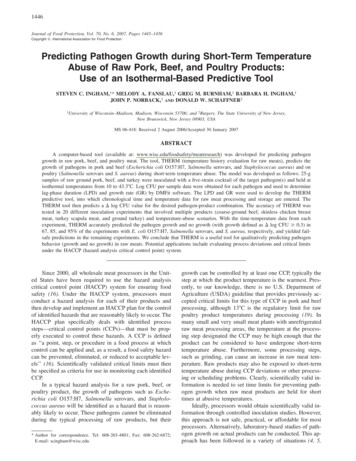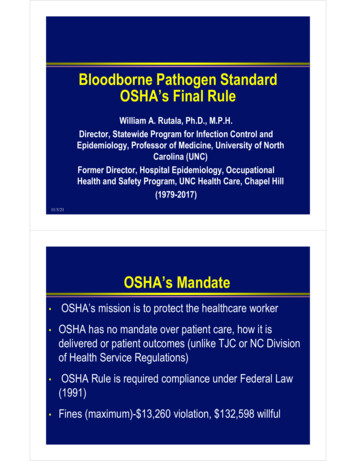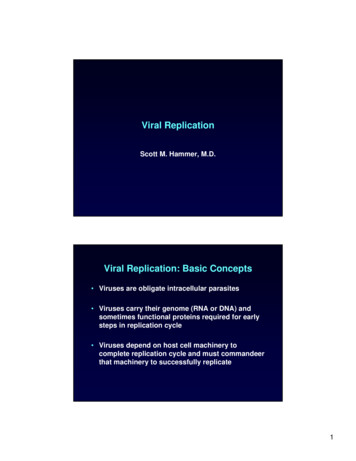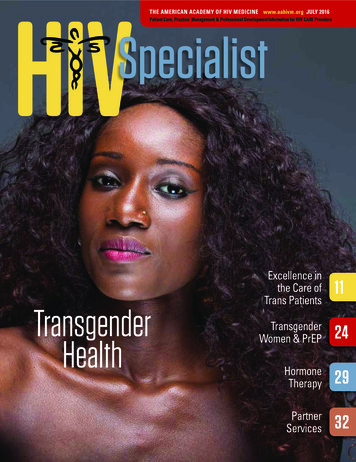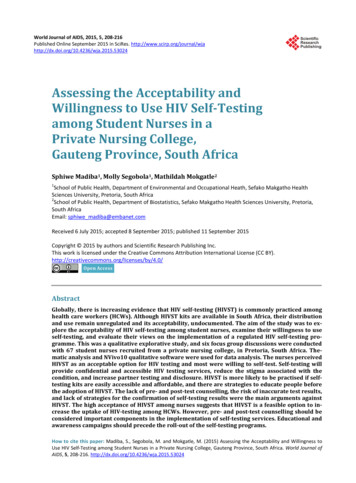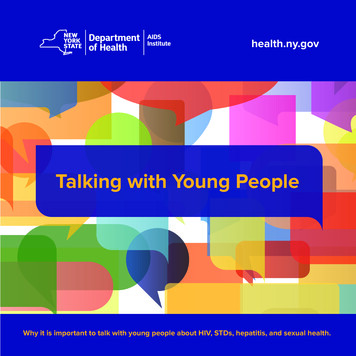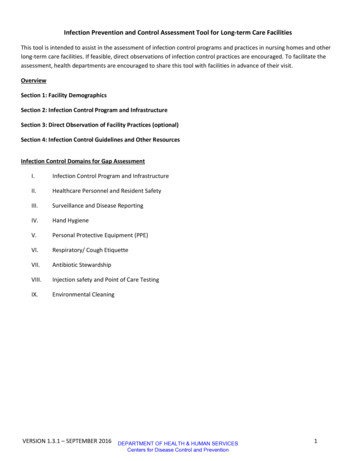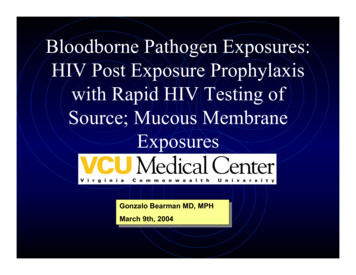
Transcription
Bloodborne Pathogen Exposures:HIV Post Exposure Prophylaxiswith Rapid HIV Testing ofSource; Mucous ,MPHMPHMarchMarch9th,9th,20042004
Outline Bloodborne pathogens listsExposure typesRisk of transmission based on exposureVCUHS data of occupational bloodbornepathogen exposures PPE: for mucous membrane exposures PEP and Rapid HIV Testing- new protocol
Potential Bloodborne Pathogens Human Immunodeficiency Virus (HIV) Hepatitis Viruses As well as agents that Creutzfeldt -Jakob DiseaseHTLV-1 InfectionsArboviral InfectionsMalariaRelapsing FeverViral Hemorrhagic FeverSyphilis
Transmission of these agents in the workplacecan occur through the following routes: Parenteral exposure - The pathogen isintroduced directly into the body through a break in theskin, needlestick, or througha cut with a contaminatedinstrument or glass. Mucous membrane exposure - Exposurethrough contact of a mucous membrane in the eye,nose or mouth.
Risk of Infection after Contact with Infected BloodPercutaneous exposure:Prospective studies of several thousand HCWs indicate that the risk ofseroconversion:HIV-infected blood is approximately 0.3%.Hepatitis B depends on the e antigen (e Ag) status of the patient.If the patient's blood is positive for the e Agthe risk of transmission -30% or about 100 times that of HIV.HCV infection is 3% to 10% or about 10 times the risk following a single exposure toHIV-infected blood.
Risk of Infection after Contact with InfectedBlood Mucous Membrane Exposure: Risk of HIV Transmission 0.09 % risk of transmission after a mucous membraneexposure to HIV infected blood. Hepatitis B and C Risk of transmission not well documented Presumed to be less than in percutaneous injury Although the risk of transmission associated withmucous membrane exposures is less, it is notnegligible
ane
Personal Protective skswithfaceshieldswith ts,carts,andwallmountedand wall mountedPPEPPEstoragestorageunitsunits
Mucous Membrane ExposuresCan be Prevented!!!!!! PPE: Masks, faceshields / goggles MUST BE WORN IN ANY PROCEDURE ORPATIENT CARE ACTIVITY THAT POSES A RISKOF BLOOD OR BODY FLUIDSPLASH/SPLATTER/AEROSOLIZATION. The include: Phlebotomy and blood cultures Suctioning of gastric or respiratory secretions Removal of medical devices– CVC, ET tubes, Foley catheters, IV lines
Reveal:Rapid HIV TestMedMira Laboratories Rapid HIV test performed on patient serum HIV antibody test SENSITIVITY: 99.8%– All positive tests are confirmed by western blot Processing time for the test (upon receipt by thelaboratory) is about 20-30 minutes. It is critical that the the source blood be drawnimmediately and delivered to the laboratory inan expeditious manner
New PEP AlgorithmD i d a p e r c u ta n e o u s o r M Me x p o s u r e o c c u r t h a t c a r r ie ss i g n if ic a n t r i s k o f t r a n s m i s s io no f H IV ?P E P n o t in d i c a te d ;n o f o ll o w - u p n e e d e dNOY esH a v e f e w e r th a n 3 6 h o u r se l a p s e d s in c e t h e e x p o s u r eo ccu rred ?Y e s : P ro c e e d w ith R a p idH IV T e s t i n gP E P n o t o p ti m a l b u ts h o u ld b e c o n s i d e r e d . I fc o n s i d e r e d - p r o c e e d w it hra p id H IV te s tin g o fs o u r c e a n d f o ll o wa l g o r i t h m a c c o r d i n g ly .NOS a m p le m u s t b e o b ta in e d S T A T (s e r u mse p a r a to r ) a n d s e n t v ia p n e u m a tic tu b e toIm m u n o lo g y L a bI s t h e s o u r c e p a t ie n t H I Vin fe c te d a s d e te rm in e d b yr a p id t e s t i n g ?NOP E P n o t in d i c a te d ;n o f o ll o w - u p n e e d e dP E P T e a m M e m b e r w ill b e n o tifie d o f b o th P O S I T I V E a n d N E G A T IV E r e su lts b yth e la b .I n it ia t e H A A R T ( I F S O U R C E I S P O S I T I V E - 3 D R U G S A R E P R E F E R R E D )T H E S E A R E S T A N D IN G O R D E R S : R e c o m m e n d e d r e g i m e n : z id o v u d i n e 3 0 0 m g p o b i d l a m i v u d i n e 1 5 0 m g p o b i d( o r C o m b iv i r 1 b i d )PLUSN e l f i n a v i r 1 2 5 0 m g p o b i d w i th f o o d P e r f o r m b a s e l in e c o n f i d e n t ia l H I V te s ti n g o f t h e e x p o s e d h e a l t h c a r e w o r k e r w i th i n 7 2h o u r s o f i n i ti a t i n g H A A R T R e f e r t o E m p l o y e e h e a l t h f o r a d d i ti o n a l m a n a g e m e n t: H A A R T , H e p a t i ti s B a n d CS o u rc e p a tie n t’s se ro lo g ic te s t isc o n f i r m e d H I V n e g a t i v e a n d t h e r e is n oe v i d e n c e o f a c u t e r e t r o v ir a l s y n d r o m e i nth e s o u r c e p a tie n t.S to p P E PS o u r c e p a tie n t’s s e ro lo g ic te s t is c o n firm e dH I V p o s it iv e o r i n d e t e r m i n a t e , o r s e r o lo g yi s u n a b l e to b e o b t a i n e d .C o n tin u e P E P fo r 4 w e e k s
Conclusion-1 Mucous membrane blood and body fluidexposures are known risk factors for thetransmission of HIV and Hepatitis B/C Of all blood and body fluid exposures at VCUHS;mucous membrane exposure account for 30%nearly every year. PPE (masks, faceshields or goggles) must be wornwhen a patient care activity poses a risk of BBFsplash, spray or aerosolization.
Conclusion –2What should you do? Be sure you communicate this informationto your staff and tell them it is yourexpectation that they comply. Be sure that supplies are available for staff. Be sure to remind and re-educate when yousee non-compliance. Document repeated non-compliance, toprotect you and the institution.
Conclusion-3 New PEP protocol Rapid HIV testing will now be employed Processing time is about 20-30minutes upon receiptof the source patient’s blood Blood must be obtained from the source in anexpeditious manner Rapid HIV test results will be reported back to thePEP member Standing orders for Antiretrovirals; 3 regimenHAART
New PEP Algorithm. Did a percutaneous or MM exposure occur that carries significant risk of transmission of HIV? Yes. Have fewer than 36 hours . Perform baseline confidential HIV testing of the exposed healthcare worker within 72 hours of initiating HAART Refer to Employee health for additional management: HAART, Hepatitis B and C .
